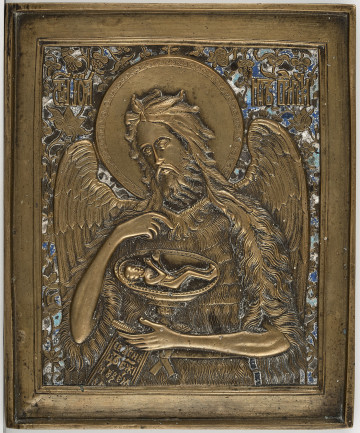
St. John the Baptist
20th century
Castle Museum in Łańcut
Part of the collection: Icons
St Nicholas, Mother of God Hodegetria, Christ with the Saints. In the Christian East, and later in Ruthenia, images were given special reverence. In Russia, this was evident both among adherents of the official doctrine and among Old Believers persecuted by the government and the Moscow Orthodox Church as a result of their rejection of the liturgical reform initiated in the mid-17th century. The supporters of the old Russian Orthodox tradition, in order to protect themselves from persecution, cut themselves off from the reformist current, which they treated as heresy, and contented themselves with the worship of cult objects made in their own environment. As a result of persecution, these were destroyed by official factors and their owners were harassed and punished. It was difficult to organise a house of prayer, called “molenna”, which for Old Believers replaced the typical Orthodox church, and its discovery could lead to arrests. In the conditions of persecution, when there was a need to quickly clean and secure objects of worship from a molenna or private home, traditional icons painted on boards could easily be damaged. Living conditions forced the Old Believers to produce durable compact products, easy to hide and transport, replacing the classical iconostasis. They began to compose the handy metal crosses and icons on wooden boards by embedding the individual devotional items in grooves or “vriezy”, hence they were called “vriezka”, “kivotka” or “kovchezhets” from the Greek words for frame, box. Sometimes the board became not only the ground for objects of worship, but also for the icon painted on it, because in the tradition-dominated notion of the sacred image, images painted on wooden substrates had a higher rank. This is shown in the exhibit in question, which features two brass icons with images of St Nicholas the Wonderworker and the Mother of God Hodegetria set in the grooves of the painted icon, with half-pictures of Christ and the adoring saints placed in the upper part of the composition. Teresa Bagińska-Żurawska https://orcid.org/0000-0002-9243-3967
Dimensions
height: 17.5 cm, width: 15 cm
Object type
Icons
Technique
tempera, cast
Material
tempera, wood, bronze
Origin / acquisition method
decyzja administracyjna
Creation time / dating
Creation / finding place
Owner
Castle Museum in Łańcut
Identification number
Location / status

20th century
Castle Museum in Łańcut

19th (?) century
Castle Museum in Łańcut

1800 — 1850
Castle Museum in Łańcut
DISCOVER this TOPIC
National Museum in Szczecin
DISCOVER this PATH
Educational path